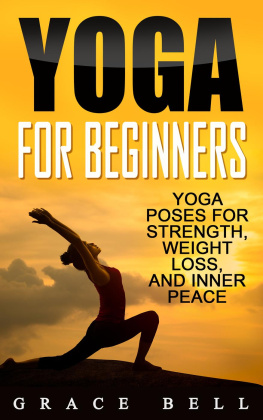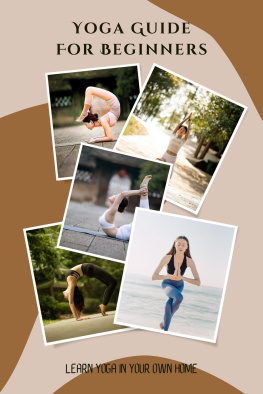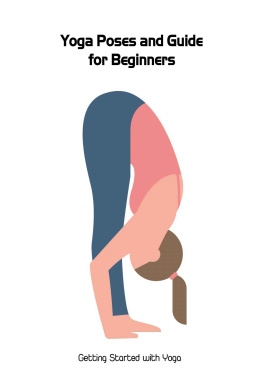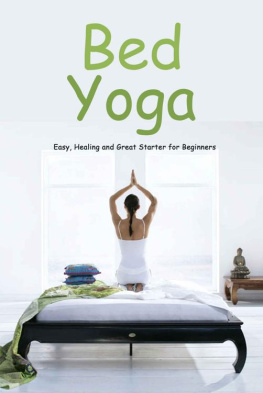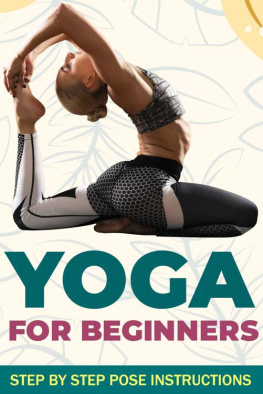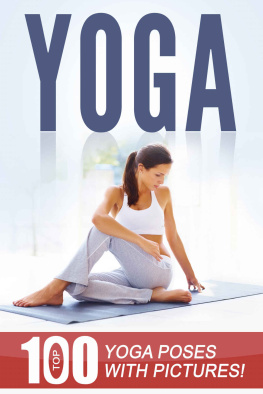This bookis dedicated to my mentor Angela, who taught me everything about inner peace.
Chapter 1- Yoga- A Brief History
Inthe world today many fitness enthusiasts have turned to yoga as a workoutprogram to help them build strength, burn body fat, increase flexibility andoverall health. Many people don't realize that yoga has been around forcenturies and has been used by many world leaders. Yoga originated in India.Yoga has both health and spiritual benefits that come from various religiouspractices over centuries.
Despitethe long history, yoga has continually changed its methods over the centuries.In the initial years, yoga focused on basic physical postures and breathingpatterns; as the centuries progressed yoga has become more advanced with alarge amount of styles, poses, and methods. The practice of Yoga has expandedover the last several decades. Below is a brief history of the activity ofyoga.

EarlyHistory
Researchhas indicated that yoga was first started back in 3000 SC. However, manyhistorians believe that yoga might have been started back in the Stone Age era.Many historical carvings, from late centuries, show ancient people using yogamoves. Many historians don't know how the people were able to learn such posesin the Stone Age. Yoga originally was a meditation method that was used bypeople to encourage a strong mind and body. In its course of history yoga hasbeen broken down into 4 periods. The periods of yoga start with the VedicPeriod followed by the Pre Classical, Classical, and Post Classical. All theseperiods play a large role in the evolution of yoga.
VedicPeriod of Yoga
Thesacred scripture of Vedas is a record of yoga. Vedas is a Brahmanism scripturethat is very similar to Hinduism. The Vedas started as song hymns that discussthe power of praise and using divine power. The Vedas used religiousceremonies, rituals, and services which made it called Vedic Yoga. Vedic peoplebegan teaching this yoga by following scriptures and using different movingpatterns to encourage the practice.
PreClassical Yoga
PreClassical yoga began with the creation of the Upanishads. The Upanishads was agroup similar to the Vedas that continued the teachings of the Vedas. TheUpanishads created 3 main subjects that were inspired and revaluated by them.The 3 subjects are; the ultimate reality, which is also known as Brahman, thetranscendental self also known as atman, and the relationship between the two.
TheUpanishads felt that Yoga creations were not only shared from Hinduism but alsoshares with Buddhism. During 600 B.C. the legend Buddha started teachingBuddhism. Buddhism preaches about Meditation and practicing physical yogapostures. The first Buddhist to study the activity of yoga was SiddharthaGautama. During this time frame yoga was still growing with the installation ofdifferent poses and methods.
ClassicalYoga
TheYoga Sutras was a document that created the classical period of yoga. Thisdocument stressed the importance of yoga postures and was believed to bewritten in 200 AC by Patanjali. The document was written to help educate peopleabout the proper techniques of yoga. Techniques, posture, and breathingtechniques were explained to help people performing the activity.
Thedocument was meant to help people understand how to perform the postures andpositions. In the past many people would make up their own postures thatwouldn't benefit them in anyway. A lot of people were also teaching incorrectpostures which created a chain reaction. There was also a very large populationof people that were not breathing correctly during the yoga sessions, whichjust led to more confusion amongst yoga enthusiasts.
TheYoga Sutras created a method called Eight Limbs of Classical Yoga. The eightlimbs are meanings for people. The 8 limbs are Yama, Niyama, Asanas, Pranayama,Pratyahara, Dharana, Dhyana, and Samadhi. During the classical time of yoga theinstructors focused on getting stronger by using the physical posturetechniques along with working on meditation skills to build the bodysconfidence and spirit; the term your body is a temple" was used.
Theyogi's wanted to make their bodies immortal. The good part about the documentwas that yoga instructors now had a good blueprint for what they wanted to doas far as teaching. The document also started making more people interested inyoga because of the benefits that they could achieve from the practice.
PostClassical Yoga
Asthe years went on Yoga became more popular and was founded by the variouscountries during the 19th century. It was first studied by students and medicalprofessionals as part of Eastern Philosophy. Yoga inspired people to be healthyin the late 1920's and this later created a generation of people that becameenthusiastic about fitness. Many new people started to become yoga instructors whichled to new yoga workout styles and methods. Instructors started to come up withdifferent poses and workout routines in the 1950's and 60's. The styles stillkept the basic yoga principals, but expanded on them making it more beneficial.
Differentstyles of yoga began to be added in books and television. The media started toget more interested in this activity. Eventually more people from across theworld started to teach yoga and add their own twists to the activity. Popularyoga instructor and Doctor Swami Sivananda opened yoga schools in Europe andAmerica. Sivananda came up with the 5 principles of yoga. Not only did hecreate the 5 principals, but he also wrote nearly 300 books on yoga whilecreating videos to show the poses. Eventually more people followed Dr.Sivananda and this led to more books, articles, and documentaries about yoga.
ModernDay Yoga
Nowadaysmore and more people have been participating in a yoga class near you. Yoga hasspecific styles for specific goals, but the basic principles still apply. Yogais currently being practiced by people of all ages and levels. Yoga is helpingsenior citizens control their breathing while adding strength with posture.World Class athletes are using yoga as a way to become stronger and more flexible.Children are learning how to use the principles to control their emotions,increase strength and stay in shape.
Chapter 2- The Benefits ofPracticing Yoga


